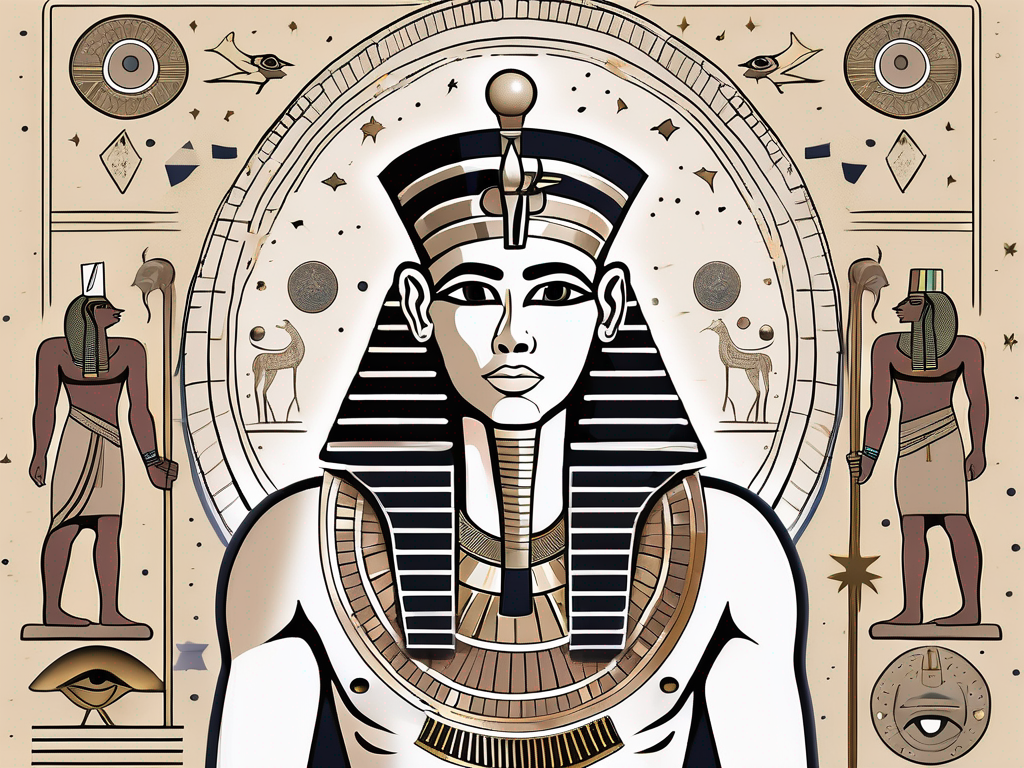Stars have always fascinated humanity. We gaze up at the night sky, mesmerized by their beauty and wonder. But what does the Bible say about stars? In this article, we’ll dive into the biblical references to stars and explore their significance from a theological and modern perspective.
Understanding Biblical References to Stars
The Creation of Stars in Genesis
In the book of Genesis, we learn about the creation of the universe. God spoke, and the stars came into being. These celestial bodies are a testament to God’s power and creativity. They serve as a reminder of His divine craftsmanship.
When we think about the creation of stars, it is truly mind-boggling. The vastness of the universe, with its billions of galaxies and trillions of stars, is beyond our comprehension. Each star is a unique masterpiece, with its own size, temperature, and luminosity. Some stars burn brightly, while others are dim and distant. The diversity of stars reflects the infinite creativity of our Creator.
Interestingly, the creation of stars is mentioned in passing in the book of Genesis, showcasing their subordinate role in the overall narrative of creation. However, this doesn’t diminish their importance in highlighting God’s glory. The mere fact that God spoke, and these magnificent stars came into existence, is a testament to His power and authority.
Stars as Symbols in Biblical Prophecy
Throughout the Bible, stars are used as symbols in prophetic texts. They often represent significant events or divine interventions. For example, the prophet Isaiah speaks of a day when the stars of heaven will not give their light, signifying a time of judgment and upheaval (Isaiah 13:10).
In the book of Daniel, stars are used to represent individuals. Daniel interprets Nebuchadnezzar’s dream, explaining that the tree being cut down symbolizes the king, while the stars falling from heaven represent his downfall (Daniel 4:20-27). This vivid imagery serves as a reminder that no one is above God’s judgment, and even the mightiest rulers will face consequences for their actions.
These prophetic references to stars remind us of God’s sovereignty and His involvement in the affairs of humanity. They show that God is not only the Creator of the stars but also the orchestrator of human history.
Stars in the Psalms: Praise and Wonder
Stunning descriptions of stars can be found in the Psalms. These poetic verses evoke a sense of awe and praise for God’s creation. Psalm 19:1 declares, “The heavens declare the glory of God; the skies proclaim the work of his hands.”
When we gaze at the night sky and see the countless stars twinkling above us, it is hard not to be filled with wonder. The psalmist marvels at the heavens and how the stars reveal God’s majesty and wisdom. They are a constant reminder of His presence and power.
Moreover, stars have always played a significant role in navigation and timekeeping. In ancient times, sailors and travelers relied on the stars to guide them on their journeys. The constellations served as celestial maps, helping people navigate through the vastness of the Earth. Even today, astronomers use stars as reference points to map the universe and understand its mysteries.
As we ponder the beauty and significance of stars, let us be reminded of the grandeur of our Creator. The stars not only illuminate the night sky but also illuminate our hearts with a sense of awe and reverence for the One who spoke them into existence.
Theological Interpretations of Stars in the Bible
Stars as Divine Beings in Biblical Texts
Some biblical passages portray stars as divine beings. In the book of Job, these heavenly bodies are described as singing together, showcasing their role in praising God (Job 38:7).
As we delve deeper into the theological interpretations of stars in the Bible, it is important to understand that while this poetic language emphasizes the grandeur of creation, it does not imply that stars possess consciousness or autonomy. Instead, it underscores their position within the cosmic order and their inherent connection to the Creator.
When we gaze up at the night sky and see the countless stars, we are reminded of the vastness of God’s creation and His power to bring order to the universe. The stars, with their radiant beauty and awe-inspiring presence, point us towards the divine and invite us to marvel at the Creator’s handiwork.
Stars as Signs and Wonders
In the New Testament, stars are associated with signs and wonders. The Gospel of Matthew tells the story of the Magi who followed a star to find the newborn King of the Jews (Matthew 2:1-12). This celestial phenomenon guided them to pay homage to Jesus.
This miraculous event reveals the significance of stars as instruments of divine communication. They can serve as heavenly markers, guiding people towards God’s purposes. Just as the star guided the Magi to Jesus, stars can also guide us in our spiritual journeys, leading us to encounter the presence of God in our lives.
When we look up at the night sky and see the stars shining brightly, we are reminded of God’s faithfulness and His desire to guide us on our path. The stars remind us that even in the darkest of nights, God’s light is always shining, offering us hope and direction.
The Star of Bethlehem: A Biblical Mystery
The Star of Bethlehem remains an intriguing biblical mystery. While the specific nature of this star is unknown, it played a significant role in the nativity story. It guided the Magi on their journey and led them to the Christ child.
Various theories have been proposed to explain the Star of Bethlehem, ranging from comets and supernovas to celestial conjunctions. Some scholars suggest that it could have been a unique alignment of planets, while others believe it was a supernatural phenomenon specifically orchestrated by God for this momentous occasion.
Regardless of its exact nature, this extraordinary celestial event serves as a powerful reminder of the birth of Jesus and the hope He brings. The Star of Bethlehem symbolizes the divine intervention in human history, marking the arrival of the Savior who would bring salvation to the world.
As we reflect on the Star of Bethlehem, we are reminded of the profound impact that Jesus’ birth had on the world. Just as the star guided the Magi to Jesus, Jesus Himself is the guiding light in our lives, leading us towards a deeper relationship with God and offering us the hope of eternal life.
Stars in Biblical Parables and Teachings
Stars in the Parable of the Sower
In one of His parables, Jesus compares the sowing of seeds to the spreading of the Word of God. He mentions that some seeds fall among thorns, which represent the cares and distractions of life, choking the seed and preventing it from bearing fruit.
However, Jesus encourages His followers by saying, “Others, like seed sown on good soil, hear the word, accept it, and produce a crop—some thirty, some sixty, some a hundred times what was sown” (Mark 4:20). They shine brightly, symbolizing the impact of a life transformed by His teachings.
When we think about stars, we often marvel at their beauty and the way they light up the night sky. In the same way, the followers of Jesus who truly embrace His teachings and allow them to take root in their lives become like stars in the world. They radiate His love, grace, and truth, illuminating the darkness around them.
Just as stars have different sizes and brightness, the impact of a transformed life can vary. Some may bear fruit thirty times what was sown, while others may produce sixty or even a hundredfold. This reminds us that the transformative power of the Word of God is not limited by our circumstances or abilities. It has the potential to bring about incredible growth and change in our lives.
Stars in the Teachings of Jesus
Jesus also compares His followers to stars in the Sermon on the Mount. He encourages them to let their light shine before others, so that they may see their good works and give glory to God (Matthew 5:14-16).
This metaphor teaches us the importance of living out our faith in a tangible way. Our actions should reflect God’s love and truth, illuminating the darkness of the world. Just as stars are visible from a great distance, our lives should be a beacon of hope and inspiration to those around us.
Furthermore, stars have been used for navigation throughout history. Sailors and travelers have relied on the stars to guide them on their journeys. In the same way, as followers of Jesus, we are called to be guides for others, pointing them towards the path of salvation and leading them closer to God.
It is not enough for us to simply believe in Jesus and keep our faith to ourselves. We are called to be active participants in His mission, shining our light brightly and making a positive impact in the world.
Stars in the Book of Revelation
In the book of Revelation, stars take on a symbolic role. They represent the messengers of the seven churches (Revelation 1:20). Each church is entrusted with spreading the light of the Gospel, guiding people towards salvation.
These stars serve as a reminder that the responsibility of sharing the good news of Jesus Christ is not limited to a select few, but is meant for every believer. We are all called to be messengers of God’s love and grace, illuminating the way for others to find eternal life.
Moreover, Jesus Himself is described as the Morning Star (Revelation 22:16), signifying His authority and divine nature. Just as stars illuminate the night sky, Jesus brings hope and salvation to a dark and broken world. He is the source of light and life, guiding us through the challenges and uncertainties of life.
As we look up at the stars in the night sky, let us be reminded of the profound symbolism they hold in the teachings and parables of Jesus. May we strive to be like stars, shining brightly with the love and truth of God, making a lasting impact on the world around us.
Modern Perspectives on Stars in the Bible
Stars in the Bible and Modern Astronomy
From a modern perspective, stars in the Bible align with our scientific understanding of these celestial objects. Astronomical discoveries have revealed the vastness and complexity of the universe, affirming the wonder and magnificence described in biblical texts.
As we delve into the study of stars, we uncover fascinating details about their formation and life cycles. Stars are born from vast clouds of gas and dust, undergoing a process of gravitational collapse that ignites nuclear fusion in their cores. This fusion releases an incredible amount of energy, causing the stars to shine brightly in the night sky.
Furthermore, through the use of powerful telescopes and advanced imaging techniques, astronomers have been able to observe different types of stars, each with its own unique characteristics. From massive, blue supergiants to small, dim red dwarfs, the diversity of stars is truly awe-inspiring.
Studying the stars not only deepens our appreciation for God’s creation but also fosters a sense of humility as we recognize our place in the cosmos. The sheer number of stars in the universe, estimated to be in the billions of trillions, reminds us of our smallness in the grand scheme of things.
Stars in the Bible: Literal or Symbolic?
The interpretation of stars in the Bible can vary. Some passages are meant to be understood metaphorically, while others describe literal celestial bodies.
For instance, in the book of Genesis, the stars are mentioned as part of God’s creation, along with the sun and moon, to mark the passing of time and seasons on Earth. Here, the stars are understood literally, as physical objects that serve a specific purpose.
On the other hand, in the book of Revelation, stars are used symbolically to represent angels or messengers. This metaphorical usage invites us to reflect on the spiritual realm and the role of heavenly beings in God’s divine plan.
It is important to approach each passage with discernment and consider the literary genre, cultural context, and overarching theological themes. By doing so, we can gain a deeper understanding of the intended message and the significance of stars within the biblical narrative.
The Bible, Stars, and Astrology: A Christian Perspective
Astrology, the belief that celestial bodies can influence human destinies, should be distinguished from the biblical understanding of stars. While the Bible mentions observations of the stars, it warns against astrology and divination.
As Christians, we are called to trust in God’s sovereignty rather than seek guidance from the alignment of stars. Our focus should be on seeking a personal relationship with God and following His will, rather than relying on the whims of the cosmos.
However, it is worth noting that the study of astronomy, which involves the scientific exploration of stars and other celestial objects, is not only compatible with Christianity but can also deepen our awe and wonder for God’s creation. By studying the stars, we gain insights into the vastness of the universe and the intricate laws of nature that govern its workings.
Moreover, the study of astronomy can inspire us to contemplate the mysteries of the cosmos and the questions of our existence. As we gaze at the night sky, we are reminded of the psalmist’s words in Psalm 19:1, “The heavens declare the glory of God; the skies proclaim the work of his hands.”
Therefore, while astrology may lead us astray, the study of stars in the context of modern astronomy can deepen our faith and appreciation for the wonders of God’s creation.
Conclusion
In conclusion, the Bible has much to say about stars. They are not mere cosmic objects but carry deep theological and symbolic significance. Stars remind us of God’s power, serve as signs and wonders, and inspire praise and wonder.
As we contemplate the vastness of the universe and the intricate beauty of the stars, may we be reminded of God’s presence in our lives. Let us shine brightly, reflecting His love and truth, and guiding others towards the hope found in Jesus Christ.












